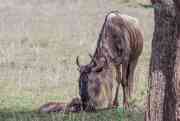African Biomes Part III: Masai Mara, Serengeti and Beyond
The African continent is huge and whether you are travelling to Cape Town or Mombasa you are in for a treat of different biospheres. From fynbos to savannah, African Budget Safaris takes a look at what fauna and flora to expect at which destinations… Oh, and just to clear this up, there are no tigers in Africa!
 Masai Mara savannah by Stephan Kennedy
Masai Mara savannah by Stephan Kennedy
What is a Biome?
Plainly put, a biome is what makes up the environment of a particular place. It is the community of plant and animal life that makes up a major habitat like a jungle or tundra. It is also the balance of this habitat that determines the animal species and relative abundance and scarcity. A biome rich in grass, for example, has the potential to support huge numbers of game as seen in Tanzania and Kenya whereas a habitat like the deserts of the Kalahari will support fewer species.
So what makes up the major biomes in Africa and what should you expect to see where?
 Mountains of Serengeti, Tanzania by William Warby
Mountains of Serengeti, Tanzania by William Warby
Masai Mara and the Serengeti
On the subject of savannah, the greatest grasslands and open plains game viewing are to be found in the Masai Mara and Serengeti. Africa's most famous safari destinations. These are the open grasslands of the great wildebeest migration and the subject of many a Planet Earth documentary narrated by David Attenborough. In fact, the Serengeti-Masai Mara ecosystems are spread over more than 24,000km² between the Serengeti in Tanzania in the south and the Masai Mara in Kenya to the north.
 Serengeti safari savannah by Marc Veraart
Serengeti safari savannah by Marc Veraart
The grasslands or savannahs provide a huge amount of sweet grasses for the vast number of grazing mammals to feed on. The herbivores follow the sweet grass that sprouts in accordance with the rain and which necessitates the great migration. It is this abundance of food for herbivores that provides food for the entire food chain. The grazers graze on masse and the predators and scavengers follow for one of the great natural spectacles in the world.
 Storm brewing on the Serengeti by Richard toller
Storm brewing on the Serengeti by Richard toller
This is the iconic view of Africa. Giraffes feasting on the succulent leaves of the umbrella tree (Acacia tortilis), herds of antelope, zebra, and wildebeest grazing the savannah as cheetah, lion, and hyena lie in wait. The Mara River, full of hungry crocs, meanders through this landscape to empty its waters into Lake Victoria in Tanzania. And off in the distance, rising hills, mountains, and volcanoes with towering cumulous nimbus storm clouds bringing much-needed rain from above.
 Balloon safari at Serengeti savannah by Chris Parker
Balloon safari at Serengeti savannah by Chris Parker
This is Africa. Well, part of it anyway…
North of the Masai Mara and Serengeti…
 Gorillas in Virunga by Ludovic Hirlimann
Gorillas in Virunga by Ludovic Hirlimann
This area is beyond the reaches of southern Africa but because of its location close to the equator, deserves a mention. Home to the rare and endangered mountain gorillas, African Budget Safaris goes off the beaten track to look at Virunga, Volcanoes National Park, the Bwindi Impenetrable Park and Lake Malawi National Park. The main reason that people visit any one of these three countries is to see the mountain gorillas. Virunga National Park in the DRC, Volcanoes National Park in Rwanda or the Bwindi Impenetrable Forest Park of Uganda.
Virunga, DRC
 Virunga National Park by MONUSCO Photos
Virunga National Park by MONUSCO Photos
Virunga is one of the truly exceptional places on earth. Stretching over 7,800 km² in the eastern part of the Democratic Republic of Congo, Virunga borders Uganda and Rwanda. It is Africa’s oldest National Park. It is also the continent’s most biologically diverse protected area and boasts glaciated peaks of the Rwenzori Mountains, active volcanoes, lava plains, erosion valleys, rainforests and even savannah.
 Rwenzori mountains by Eriksson
Rwenzori mountains by Eriksson
Home to the critically endangered mountain gorillas Virunga also contains within its borders populations of lowland gorillas and chimpanzees. Throw in another endangered species the okapi, large colonies of hippos, both savannah and forest elephants as well as lions and many rare bird species and it is no wonder that this park is also a UNESCO World Heritage Site.
North, Central and South
 Rwenzori mountain snow by Eriksson
Rwenzori mountain snow by Eriksson
The northern sector is home to the famous and once-mythical mountains of the moon. The Rwenzori Mountains which border Uganda are permanently snow-capped. The snowmelt from these icy reservoirs is one of the sources of the Nile. Below the peaks in the Semliki River valley, you will find okapis. The biomes that can be found here are lake shores, savannah, riverine forest (lowland forest), and alpine forest on the Rwenzori mountain slopes.
 Water cascading into Lake Edward by MONUSCO Photos
Water cascading into Lake Edward by MONUSCO Photos
The central sector of the park is defined by Lake Edward, the Rwindi plains, and the Ishasha river valley. Lake Edward and the adjacent Ishasha River valley are home to the recovering populations of hippo (which were once the largest in Africa). The fertile savannah of the Rwindi plains hosts the highest concentrations of buffalo, warthogs, and elephants. The predominant biomes of the central sector of Virunga are savanna, marshland, riverine forest and lakeshores.
 Ishasha valley by Bart Wursten
Ishasha valley by Bart Wursten
The southern sector is made up of lava flows (both old and new), montane tropical forest (home of the mountain gorillas) and alpine forest on the higher slopes of the Virunga massive. The southern sector is where tourists visit to spend time with the critically endangered mountain gorillas that live on the flanks of the Mikeno volcano. It is the dense forest vegetation that covers most of the southern sector that makes it an ideal habitat for not only the mountain gorillas but also chimpanzees and other monkey species.
Volcanoes National Park, Rwanda
Bordering on Virunga in the DRC and the Mgahinga Gorilla National Park in Uganda, Volcanoes National Park is Rwanda’s slice of this majestic region. Located in the northwest of Rwanda the park is a haven for mountain gorillas and golden monkeys. But its true claim to fame and the reason it has its very exciting name is the fact that it is home to five of the eight volcanoes of the Virunga Mountains! These volcanoes are Bisoke, Gahinga, Karisimbi, Muhabura and Sabyinyo. This relatively small 160 km² park was zoologist Dian Fossey’s base and is covered in rainforest and bamboo.
 Bamboo forest in Volcanoes National Park, Rwanda by John Cooke
Bamboo forest in Volcanoes National Park, Rwanda by John Cooke
Containing no fewer than five volcanoes the park has a large altitudinal range and consequently contains a variety of vegetation. From 2,400m to 2,500m is Neoboutonia forest, from 2,500m to 3,200m (about 30% of the park) its bamboo forest or Arundinaria Alpina. Then, mostly on the humid south and west slopes (also about 30%) between 2,600m and 3,600m, you will find hagenia-hypericum forest. The vegetation from about 3,600m to 4,200m is made up of lobelia and senecio species which cover about 25% of the park and lastly at altitudes of 4,300m to 4,500m grassland occurs. There are other vegetation types including lower montane forest (mostly agricultural land now), secondary thickets, meadows, marshes, swamps, and small lakes.
 Mountain gorilla in Volcanoes National Park by Karen Foley Photography
Mountain gorilla in Volcanoes National Park by Karen Foley Photography
Bwindi Impenetrable National Park, Uganda
Bwindi Impenetrable forest is very rugged. The narrow valleys are intersected by rivers and steep hills and the elevations range from just over 1,000m to almost 2,700m. The forest that is found here is an important catchment area where water flows through large fault structures. The park has a dense network of streams and so is the source of a number of rivers that flow north, west, and south. Bwindi is an important park for the conservation of Afromontane species including gorillas, chimpanzees, L’hoest’s monkeys, black and white colobus, red-tailed, and vervet monkeys as well as African elephants, green broadbills, and giant forest hogs.
 Bwindi impenetrable forest by Travel Stock
Bwindi impenetrable forest by Travel Stock
The climate of Bwindi Impenetrable Park is tropical and the park experiences high rainfall and the forest helps to regulate the climate of the surrounding areas. The Impenetrable forest is old, complex and botanically rich. It is because of its ecological importance and large biodiversity that it too has become a UNESCO World Heritage Site.
 Bwindi National Park by Bwindi NP
Bwindi National Park by Bwindi NP
Located where the plains and the mountain slopes meet, the type of forest that occurs here is described as Afromontane. There is a continuum of low altitude to high altitude primary forests which contain more than 220 tree species, which is 50% of Uganda’s tree species including the endangered brown mahogany and over 100 different types of ferns. It is one of only a handful of Afromontane forests that extends from low to high altitudes.
Lake Malawi National Park, Malawi
Lake Malawi is included in our list because of its unique fish species. Located in the Great Rift Valley, Lake Malawi National Park consists of about 95 km² of land and freshwater lake. The park includes the Nankumbu Peninsula, a mountainous headland clad in dense forest. But the real gem of this park and the reason that it was declared a UNESCO World Heritage Site in 1984 is under the water.
The fish that live in the lake have undergone extreme speciation, an evolutionary process of dividing into new and distinct species. This speciation has resulted in an estimated 700 distinct species of cichlid fish within Lake Malawi and a known 350 occurring in Lake Malawi National Park. Astoundingly, nearly all of them are endemic! Some have minute ranges, a single bay, rocky islet or a few hundred meters of shoreline… it is thought that many remain unknown to science and are yet to be described.
 Lake Malawi cichlids by Radek Borovka
Lake Malawi cichlids by Radek Borovka
Africa is your oyster
With so many amazing places to go, there is something for every taste. Africa really is your oyster.
 The great migration by Michiel Van Balen
The great migration by Michiel Van Balen
Budget Tours to places mentioned above:
If you liked this post, these trips cover similar ground…
- 3 Day Rwanda Gorillas Safari
- Rwanda Gorilla Trekking & Primate Tracking Tour
- 4 Day Lake Nakuru & Masai Mara Safari (Luxury Camping)
- 3 Day Fly-in Masai Mara Safari to Exclusive Camp
- 5 Day Lake Nakuru & Masai Mara Safari in Kenya
- 15 Day Kenya Masai Mara & Uganda Gorilla Safari (Africa Tour Overland)
- Lake Malawi & Zambia Safari in South Luangwa Valley
- Southern Malawi Safari (Budget Lodge Tour)
- 16 Day Zanzibar to Victoria Falls Africa Overland Camping Safari
- Malawi & Zambia Safari - Budget Small Group Tour



 On the outskirts of Marloth Nature Reserve, Andrew can be found walking and swimming in the beautiful Langeburg Mountains. He is passionate about animals, birds, reptiles, and plants and loves nothing more than an adventure in nature. An established artist with a master's in English literature, Andrew has traveled far and wide but South Africa still has his heart.
On the outskirts of Marloth Nature Reserve, Andrew can be found walking and swimming in the beautiful Langeburg Mountains. He is passionate about animals, birds, reptiles, and plants and loves nothing more than an adventure in nature. An established artist with a master's in English literature, Andrew has traveled far and wide but South Africa still has his heart.








